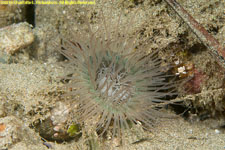 Tube anemone, Pachycerianthus sp.
Tube anemone, Pachycerianthus sp.We took an underwater photography trip to the Philippines in December 2016.
Tube-dwelling anemones, or ceriantharians, are not closely related to sea anemones. They live inside and can withdraw into tubes which are composed of a fibrous material made from secreted mucus and threads of nematocyst-like organelles (phychocysts). They have a crown of tentacles composed of two whorls of different-size tentacles. The large outer tentacles extend outwards, taper to a point, and are used mostly for food capture and for defense. The smaller inner tentacles are held more erect and are used for food manipulation and ingestion.
 Tube anemone, Pachycerianthus sp.
Tube anemone, Pachycerianthus sp.
Sea anemones are named for the anemone, a terrestrial flower. These Anthozoa have large polyps that allow for digestion of larger prey. As Cnidarians sea anemones are related to corals, jellyfish, tube-dwelling anemones, and hydras. Many form symbiotic relationshiops with zooxanthellae that live within their cells. An adhesive foot, the basal disc, connects the polyp to the surface beneath it, The column-shaped body ends in an oral disc. The mouth is in the middle of the oral disc. The tentacles have cnidocytes containing stinging nematocysts with venom vesicles. The venom paralyzes prey so that the anemone cna move it to the mouth. Most are harmless to humans.
©2016, 2017, 2024 Mermaid Underwater Photographic. All Rights Reserved.
Contact us at mermaid@underwater.org.
Last modified 31 October 2024